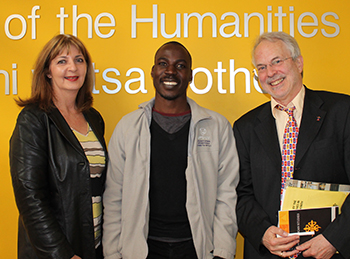Latest News Archive
Please select Category, Year, and then Month to display items
11 June 2021
|
Story Rulanzen Martin
|
Photo Courtesy of artists and the Johannes Stegmann Gallery.
![]()
Liminality is an exhibition of first-, second- and third-year student’s work in the
Department of Fine Arts at the University of the Free State (UFS). The works are from 2019 and 2020. Created during the hard lockdown of 2020, the artworks provide a glimpse of what students had to deal with and overcome during these times.
In a proposal for the exhibition, Angela de Jesus, Curator of the UFS Art Galleries, wrote: “The subtitle of the exhibition is ‘threshold, transition, transformation’ and it refers to the creative processes that students engaged with
in these adverse circumstances resulting in a wide array of artworks in both traditional and adapted mediums.”
The exhibition speaks to our shared experiences of insecurity, fragility, and discord, and to the resourcefulness and immutability of creative expression.
The virtual exhibition runs until 2 July 2021.
The exhibition is also currently available for viewing at the Johannes Stegmann Art Gallery, Sasol Library, UFS Bloemfontein Campus. Monday - Friday 09:00 - 16:00.
 MEGAN JOHNS, Battleground, Tobacco, charcoal dust, plaster of paris and resin, 93.5 x 50 x 7.5 cm
MEGAN JOHNS, Battleground, Tobacco, charcoal dust, plaster of paris and resin, 93.5 x 50 x 7.5 cm
 JACOBETH SELINGA, Linda, Installation: Found bed, wool and thread, 257 x 196 x 91 cm
JACOBETH SELINGA, Linda, Installation: Found bed, wool and thread, 257 x 196 x 91 cm
 POLOKO MOHANOE, Prayer for rain, Gouache on Fabriano, 66 x 72.8 cm
POLOKO MOHANOE, Prayer for rain, Gouache on Fabriano, 66 x 72.8 cm
 SEBOTSE SELAMULELA, In my image (Coronavirus head), Clay, 35 x 40 x 60 cm
SEBOTSE SELAMULELA, In my image (Coronavirus head), Clay, 35 x 40 x 60 cm
 WILLIAM SHAER, Creator, Deconstructed chair, koat wood and Imbura wood, 100 x 75 x 45 cm
WILLIAM SHAER, Creator, Deconstructed chair, koat wood and Imbura wood, 100 x 75 x 45 cm
 Johannes Stegmann Gallery
Johannes Stegmann Gallery
 Interior of the Johannes Stegmann Gallery
Interior of the Johannes Stegmann Gallery
Expert in Africa Studies debunks African middle class myth
2016-05-10

From left: Prof Heidi Hudson, Director of the Centre for Africa Studies (CAS), Joe Besigye from the Institute of Reconciliation and Social Justice, and Prof Henning Melber, Extraordinary Professor at the CAS and guest lecturer for the day.
Photo: Valentino Ndaba
|
Until recently, think tanks from North America, the African Development Bank, United Nations Development Plan, and global economists have defined the African middle class based purely on monetary arithmetic. One of the claims made in the past is that anyone with a consumption power of $2 per day constitutes the middle class. Following this, if poverty is defined as monetary income below $1.5 a day, it means that it takes just half a dollar to reach the threshold considered as African middle class.
Prof Henning Melber highlighted the disparities in the notion of a growing African middle class in a guest lecture titled A critical anatomy of the African middle class(es), hosted by our Centre for Africa Studies (CAS) at the University of the Free State on 4 May 2016. He is an Extraordinary Professor at the Centre, as well as Senior Adviser and Director Emeritus of the Dag Hammarskjöld Foundation in Sweden.
Prof Melber argued that it is misleading to consider only income when identifying the middle class. In his opinion, such views were advanced by promoters of the global neo-liberal project. “My suspicion is that those who promote the middle class discourse in that way, based on such a low threshold, were desperate to look for the success story that testifies to Africa rising.”
Another pitfall of such a middle-class analysis is its ahistorical contextualisation. This economically-reduced notion of the class is a sheer distortion. Prof Melber advised analysts to take cognisance of factors, such as consumption patterns, lifestyle, and political affiliation, amongst others.
In his second lecture for the day, Prof Melber dealt withthe topic of: Namibia since independence: the limits to Liberation, painting the historical backdrop against which the country’s current government is consolidating its political hegemony. He highlighted examples of the limited transformation that has been achieved since Namibia’s independence in 1990.